Ghormeh sabzi is a classic Persian stew made with fresh green herbs like parsley, cilantro, fenugreek and scallions. It is an aromatic and delicious stew served with fluffy Persian rice.

There are certain foods and aromas that evoke strong childhood memories for me. Being Persian, even half Persian, meant food was a big part of our family. We ate dinner together every night.
When it came to extended family, those gatherings involved tables overflowing with food. Back in Iran, we would meet at my grandparents’ apartment for weekly family meals. As I walked up the stairs and down the hallway, I could smell my favorite stew, khoresteh ghormeh sabzi.
And when I make this stew for my family, the smell takes me back to my grandmother’s weekly dinners.
Why this recipe is so crazy awesome
Ghormeh Sabzi is a staple stew in most Persian households. It is traditionally made with parsley, cilantro, fenugreek and green onions. It’s the combination and quantities of each of these herbs that makes every version unique the cook preparing it.
Although not a terribly complicated meal, ghormeh sabzi is a bit labor intensive. Most of the work is spent washing and cleaning the herbs. For the parsley, I trim off the excess stems. For the cilantro, I’m not as picky about the stems, but I definitely remove the fat woody ones.
Everything gets chopped up nicely in the food processor. Although it is very possible to chop the herbs by hand, I have done it, it will take MUCH longer than whirling it through the handy food processor.

Today at middle eastern grocery stores, you can find dried herb packets to make this dish. Some people make their own dried herb combinations. My mother-in-law has her favorite brand of gormeh sabzi mix she likes to use.
But, to be honest, I do know many people who make this dish using only dried herbs. It certainly is easier using dried herbs, but the flavor and texture is different compared to using fresh herbs.
My personal preference? Fresh herbs are best. The only dried herb I use in this dish is fenugreek, because it is very difficult finding fresh fenugreek here in the US. Sometimes I add a little dried parsley and/or cilantro when I didn’t buy enough fresh herbs.
The strong pungent smell of khoresteh ghormeh sabzi is from the fenugreek. The amount, again, is dependent on the preferences of the person cooking the meal. My mother tells me she uses very little fenugreek because it smells up the house.
But for me, it’s all about that beautiful smell. And remembering my grandmother. So I never skimp on the fenugreek. When the kids come home from school, they can smell this dish as they approach the door and now they smile in anticipation.
Ingredients you need

This post contains some affiliate links for your convenience (which means if you make a purchase after clicking a link I will earn a small commission but it won’t cost you a penny more)! Read my full disclosure policy
- Stew meat: You can prepare this stew with beef or lamb shanks. But here in the US, beef stew meat is more available and affordable. I like to cut up my own stew meat from London Broil or a Chuck Roast. For a vegetarian version, a dear friend of mine uses baby portobello mushrooms.
- All purpose flour: I like to add a little flour to the stew so it will thicken the juice a little bit. This is totally optional and can be omitted if you do not want to use it.
- Onions: I use regular brown onions, but you can also use white onions.
- Beef broth: Traditionally, only water is added to the stew. But I like to add beef broth for more flavor. You can also use vegetable broth or just water.
- Fresh herbs: This stew uses fresh parsley, cilantro and green onions.
- Other greens: I also like to add some frozen spinach (which is chopped and cleaned for me!) to the stew. I have also added fresh kale, with the stems removed. You can also skip this and just add an extra bunch parsley instead.
- Fenugreek: This is the only herb that I used dried, becuse I have never found fresh fenugreek!
- Persian dried limes: Limoo Omani offers a very unique sour flavor. Persians use these dried limes whole in our soups and stews. As it cooks, the lime softens. Many love to eat these cooked limes, breaking it up on their plate. I personally, do not eat them and discard them after the stew is done cooking.
- Lemon juice: For a different dimension of sour, I add lemon juice as well.
- Red kidney beans: I love using large kidney beans in this stew. You can also use the small variety. Some people use pinto beans instead. I prefer the convenience of canned beans, but you can totally used dried beans. Just be sure to prepare prior to making the stew.
- Extra virgin olive oil: I sauté everything with extra virgin olive oil. You can use any vegetable oil.
- Turmeric: Dried turmeric is a staple spice in the Persian kitchen.
- Pantry staples: Salt and pepper

Tools to Use
Step-by-step directions
1. In a large bowl combine stew meat, turmeric, salt, pepper and flour (optional). You want the meat evenly coated with the flour and seasonings.


2. In a large Dutch oven cook diced onions in olive oil until they start to to turn translucent. Stir in turmeric and salt and cook until the color deepens. Some people cook the onions until caramelized.


3. Raise heat back to high and when onions and oil are crackling, add the seasoned meat and brown it on all sides.

4. Once browned, stir in beef broth. Scrape bits that have browned on the bottom of the pot and bring broth to boil, then reduce to low heat. Cut slits into dried limes and add to the pot, cover and cook on low heat for 1 hour.
Once limes have softened, you can press them flat with your wooden spoon to remove the air inside.

5. While meat is cooking, remove stems, especially the thick woody ones, from parsley, cilantro and kale (if using). Wash, drain and spin green vegetables dry. A salad spinner works great with this step.
Once dried, chop vegetables in batches using a food processor with a metal blade.


6. Using a large frying pan, sauté in batches the chopped green onions with the processed herbs. When the vegetables turn dark green, add some of the dried fenugreek and cook until incorporated.
Now some Persians like to cook the herbs until their nearly black. You can see comments below that “ghormeh sabzi is supposed to be a very dark green.” Well, a lot of that is from dried herbs. I prefer to use fresh herbs.
I do not believe in nearly burning my herbs. I do cook them until they are “dark.” How long that takes is usually dependent on how tired or impatient I am at the time!
Feel free to cook the herbs as long and as dark as you like.


7. Transfer mixture the pot with the stew meat then continue to sauté the rest of the herbs and greens. Stir in water and lemon juice and simmer the stew for at least an hour or two.
The longer the stew cooks, the more fragrant and flavorful your stew will be. I usually cook it for an hour, cool it and refrigerate it overnight. Then the next day, I reheat it and cook it for another hour.

8. Drain liquid from canned red kidney beans and soak in a bowl of water for 2 hours. This step is optional. By soaking the canned beans in water, you reduce the gassy side effects of the beans. Seriously, life changing tip!
Drain beans, stir in with the stew and cook for one more hour.

Expert tips and recipe FAQs
I started adding other green vegetables to my gormeh sabzi after I had kids. Wanting to get them to eat more greens, I began adding spinach to the stew. No one noticed the difference.
Since I always had frozen spinach in the freezer, it was easy to add and it became a staple ingredient. I have recently started adding kale (kalam-e peech) to my stew and again, no one noticed a difference.
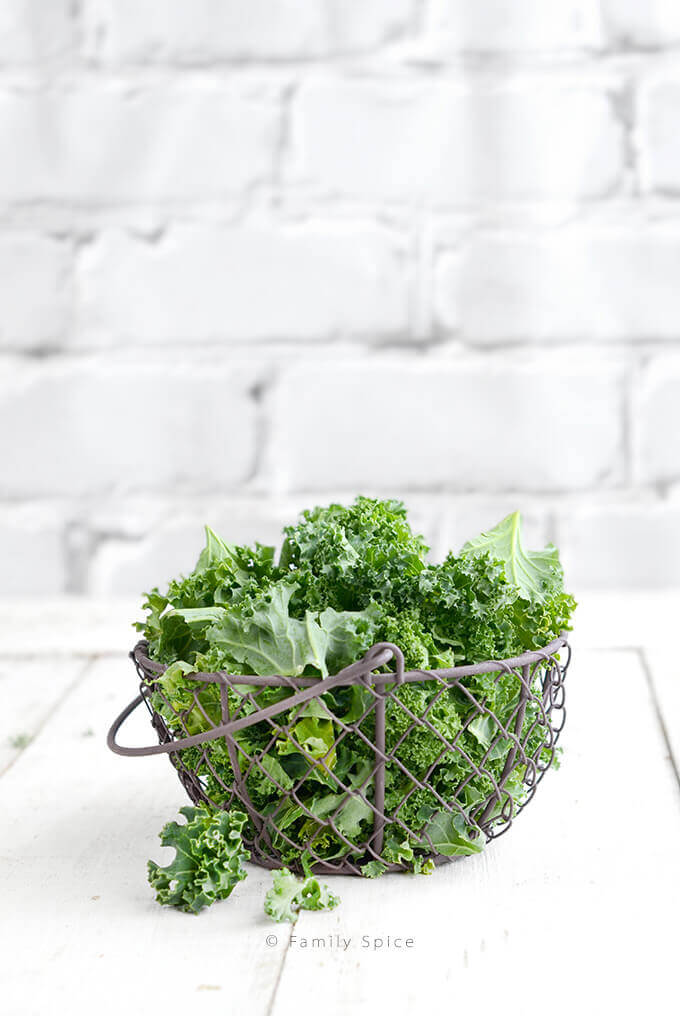
The sourness of the stew comes from lemon juice as well as dried Persian limes (those shriveled up brown balls pictured below). You can just use lemon juice, but the flavor of the dried limes (limoo amani) is very distinct and used in almost all of Persian stews.
I usually pierce each lime with a sharp knife before adding them to the stew, to help them soak up the stew’s juices more quickly. You can use ground limoo omani, just use sparingly as a little goes a long way.

This delicious stew is usually served over a bed of Persian rice. You can also serve with Shirazi salad or some mast-o khiar on the side. I personally prefer to enjoy a huge helping of stew with a little bit of rice and some radishes on the side.
OMG I’m drooling just thinking about it.
Got an Instant Pot? You can also make gormeh sabzi in the Instant Pot! I’ve got the full directions for instant pot ghormeh sabzi here. I even have a video.
So don’t be intimidated by this dish. It might take a bit of work to prepare, so do it over the weekend so you can enjoy it later during the week.
What food takes you back to your childhood?

Yes, you CAN freeze ghormeh sabzi to enjoy another day. My husband keeps asking me to make a giant pot and freeze half of it. What he doesn’t understand is that I do make a giant pot, but we all love it so much and can’t help ourselves.
Yes, you CAN make ghormeh sabzi days before you are going to serve it. In fact, Persian stews taste even better the next day. I don’t usually serve this stew the same day that I prepare it. I spend one day cleaning de-stemming the herbs, then a second day cooking everything just to serve it on the third day. So worth it!


If you are enjoying my recipes, please sign up for my newsletter and get my free 28-day meal plan! You can also follow me on Instagram or Facebook.
Ghormeh Sabzi - Persian Herb Stew
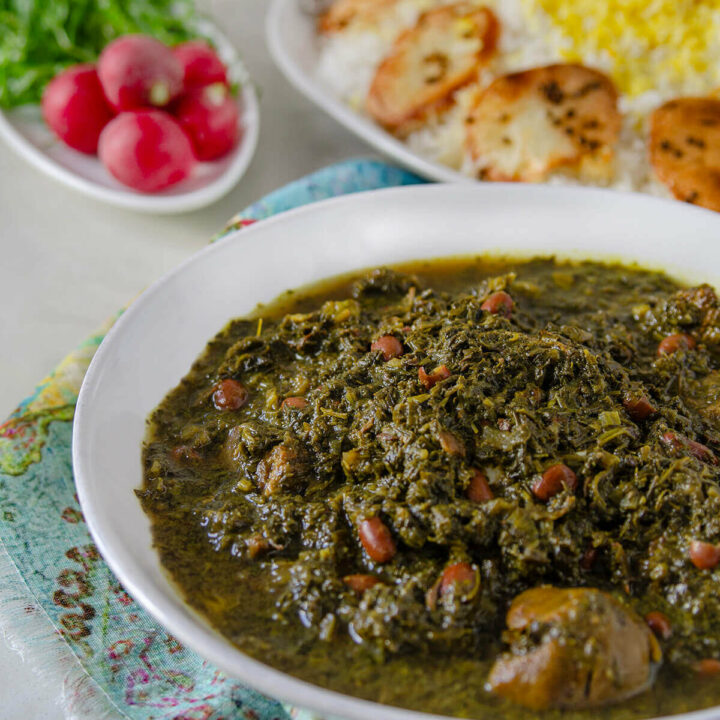
Ghormeh sabzi is a classic Persian stew made with fresh green herbs like parsley, cilantro, fenugreek and scallions. It is an aromatic and delicious stew served with fluffy Persian rice.
Ingredients
- 3 lb stew meat, 1-inch cubes
- 3 teaspoon turmeric, divided
- ¾ teaspoon salt
- ⅛ teaspoon black pepper
- 2 TBS all purpose flour (optional)
- 9 TBS extra virgin olive oil, divided
- 3 cups diced onions
- 2 cups beef broth
- 6 small dried Persian limes
- 26 oz fresh parsley (approximately 6 big bunches)
- 10 oz fresh cilantro (approximately 4 bunches)
- 9 oz fresh kale (7 oz kale without stems)
- ½ cup dried fenugreek, divided
- 8 oz fresh green onions (approximately 2 bunches)
- 4 cups water
- ¼ cup lemon juice
- 20-ounces canned red kidney beans
Instructions
- In a large bowl mix together stew meat, 2 teaspoon turmeric, ½ teaspoon salt, ⅛ teaspoon pepper and 2 TBS flour (optional).
- In a large Dutch oven over medium high heat add 3 TBS olive oil and diced onions.
- Cook until onions start to soften, then reduce heat to medium-low and cook until translucent, just before caramelizing.
- Stir in 1 teaspoon turmeric and ¼ teaspoon salt with the onions.
- Raise heat back to high and when onions and oil are crackling, brown seasoned stew meat on all sides. Once browned, stir in beef broth.
- Scrape bits that have browned on the bottom of the pot and bring broth to boil, then reduce to low heat.
- Cut slits into dried limes and add to the pot, cover and cook on low heat for 1 hour. Once limes have softened, you can press them flat with your wooden spoon to remove the air inside.
- While meat is cooking, remove stems, especially the thick woody ones, from parsley, cilantro and kale.
- Wash, drain and spin green vegetables dry. A salad spinner works great with this step.
- Once dried, chop vegetables in batches using a food processor with a metal blade.
- Using a large non-stick frying pan, over medium-high heat add 2 TBS olive oil.
- Sauté half of the green vegetables in the hot oil, stirring in fenugreek.
- Reduce heat to medium and continue cooking until vegetables are dark green. Transfer to the pot with the stew meat.
- Add 2 TBS olive oil to the hot frying pan and sauté the second half of green vegetables in the hot oil, stirring in ¼ cup fenugreek.
- Again, cook until vegetables are dark green. Transfer to the pot with the stew meat.
- Clean and dice, both green and white parts of green onions.
- Add 2 TBS oil to the hot frying pan and sauté the green onions in the hot oil until onions are lightly browned and greens are dark. Transfer to the pot with the stew meat.
- Stir in 4 cups water and ¼ cup lemon juice the stew.
- Cover pot, reduce heat of stew to low and cook for at least an hour or two. The longer the stew cooks, the more fragrant and flavorful your stew will be. Ideally, you can serve the stew the next day.
- Drain liquid from canned red kidney beans and soak in a bowl of water for 2 hours. This step is optional. By soaking the canned beans in water, you reduce the gassy side effects of eating beans.
- Drain beans, stir in with the stew and cook for one more hour.
- Serve with Persian rice.
Notes
My family likes our stews with a lot meat in it. Most people serve it with less meat, whether by choice or because of cost. You can reduce the meat to 2-pounds.
You can use large or small red kidney beans, as well as pinto beans.
Instead of kale, I like to use frozen chopped spinach. You can also use fresh spinach. I prefer frozen since all the cleaning and chopping is done for me! You can also omit both of these and substitute with an extra bunch of parsley instead.
You can make this stew several days before serving it. In fact, it tastes better this way and most people do not serve ghormeh sabzi the same day they make it! You can also freeze leftovers.
For a vegetarian option, use vegetable broth instead of beef. Instead of stew meat, a vegan friend of mine uses mini portobello mushrooms instead. It is actually very tasty!
You can use already cut stew meat, but I prefer to cut my own. I use London Broil or Chuck Roast. You can also use lamb or beef shanks, as the bones add terrific flavor to the stew.
Nutrition Information:
Yield:
10Serving Size:
1Amount Per Serving: Calories: 560Total Fat: 23gSaturated Fat: 6gTrans Fat: 1gUnsaturated Fat: 16gCholesterol: 135mgSodium: 522mgCarbohydrates: 37gFiber: 12gSugar: 5gProtein: 57g
PS If you try this recipe, why not leave a star rating in the recipe card right below and/or a review in the comment section further down the page? I always appreciate your feedback.
You can also follow me on Pinterest, Facebook or Instagram. Sign up for my eMail list, too!




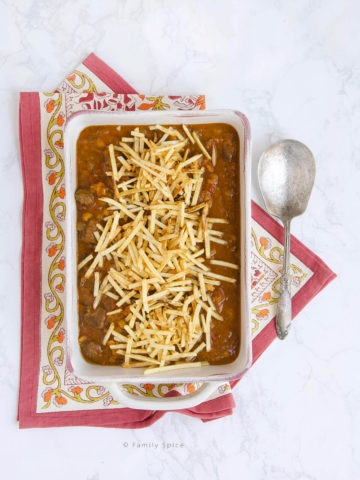


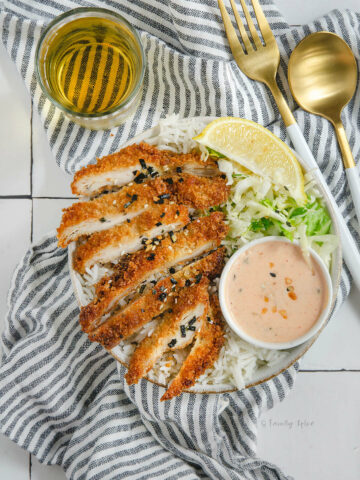
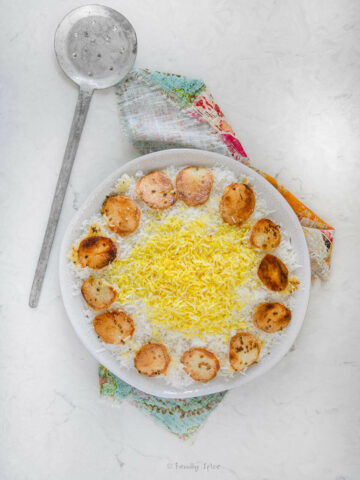

Hi! I just tried this!!!! Question though – Do you leave the dried limes in there when you serve it, or do you discard them? : )
Great question, Jeanne! You leave the dried limes in the stew. BUT, not everyone likes to eat them. Sometimes, I chop them up and let them melt into the stew. Persians like their lemons, so many dishes have a sourness some people do not like. If I’m serving mixed company or my family, I keep the lemons whole or in big chunks so those who don’t like it too sour, can avoid it. My husband takes a whole lime and chops it in with his stew and rice right before he eats it. That’s a bit too sour for me!… Read more »
Actually, I LOVE it! I’m just making it for the second time this week. This time I’ve mixed up the greens and I’m just putting in everything in the fridge… beet greens, kale, spinach, etc. So good!
What a unique dish. So full of nutrients with all that kale and greens (I have to admit, I couldn’t add the cilantro, as I’m one of THOSE people)! 🙂 Wish the US would adopt this type of dish into their menus as ours are causing health issues, especially with children.
The mixture of herbs in this dish sounds so wonderful!!! I need to try this! This would make the perfect comforting dish on a cold Winter’s night!
All the fresh parsley and cilantro looks wonderful – so refreshing! And I just love the great nutrition from the kidney beans and kale, too! Such a lovely dinner recipe!
This looks spectacular. I can’t wait to give it a try.
This looks filling and delicious! I am in love with kale!
Absolutely stunning! My kind of meal for sure, love this!
Hi, actually I did’nt expect to see this food here. A food that always we used to eat it with delicious,soft and good smelly rice every Jomeh. sometimes in childhood maybe I if forgot what day it is, but by smelling Khoresht Sabzi, I realized that today is Jomeh 🙂 our khoresht sabzi was a little different in appearance with something that I saw in these pics. specially my grandmother’s one. ours are darker than this I think, specially my grandma’s 🙂 maybe the reason that our vegetable color is darker and more black when the food is ready, is… Read more »
Yes, many people fry the vegetables much longer than I do. My husband complains that mine goes not leave an oily streak on his plate like his mother’s! I don’t use as much oil as she does, but it’s still delicious. And you are right about the smell – that beautiful smell!